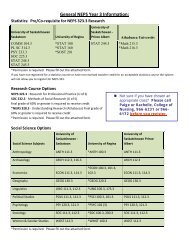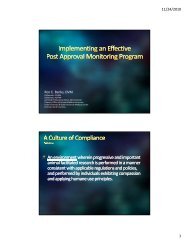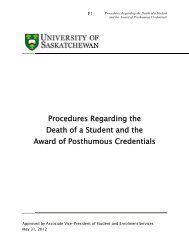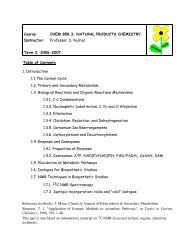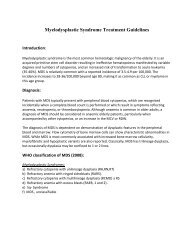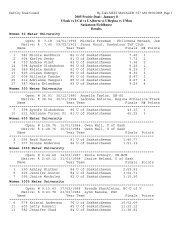Identification and Quantification of Estrogen Receptor Agonists in ...
Identification and Quantification of Estrogen Receptor Agonists in ...
Identification and Quantification of Estrogen Receptor Agonists in ...
Create successful ePaper yourself
Turn your PDF publications into a flip-book with our unique Google optimized e-Paper software.
<strong>Identification</strong> <strong>and</strong> <strong>Quantification</strong> <strong>of</strong><br />
<strong>Estrogen</strong> <strong>Receptor</strong> <strong>Agonists</strong> <strong>in</strong><br />
Wastewater Effluents<br />
SHANE A. SNYDER,*<br />
DANIEL L. VILLENEUVE,<br />
ERIN M. SNYDER, AND JOHN P. GIESY<br />
Department <strong>of</strong> Zoology, National Food Safety <strong>and</strong><br />
Toxicology Center, <strong>and</strong> Institute for Environmental<br />
Toxicology, Michigan State University,<br />
East Lans<strong>in</strong>g, Michigan 48824-1311<br />
Total concentrations <strong>of</strong> several known xenobiotic estrogen<br />
receptor (ER) agonists <strong>and</strong> natural <strong>and</strong> synthetic estrogen<br />
were measured <strong>in</strong> water by use <strong>of</strong> a comb<strong>in</strong>ation <strong>of</strong><br />
<strong>in</strong>strumental <strong>and</strong> bioanalytical approaches. Samples from<br />
3 municipal wastewater treatment plants (WWTPs) <strong>in</strong><br />
south central Michigan (upstream <strong>and</strong> effluent); 4 po<strong>in</strong>t<br />
source locations on the Trenton Channel <strong>of</strong> the Detroit River,<br />
MI; <strong>and</strong> 5 locations <strong>in</strong> Lake Mead, NV were analyzed.<br />
Organic compounds were extracted from 5 L water samples<br />
us<strong>in</strong>g solid-phase extraction disks <strong>and</strong> separated <strong>in</strong>to<br />
three fractions based on polarity. Whole extracts <strong>and</strong><br />
fractions were tested for ER agonist potency us<strong>in</strong>g the<br />
MVLN <strong>in</strong> vitro bioassay. ER agonist potency was characterized<br />
by compar<strong>in</strong>g the magnitude <strong>of</strong> <strong>in</strong>duction elicited by the<br />
extract or fraction to the maximum <strong>in</strong>duction caused by 17estradiol<br />
(E2). The greatest concentrations <strong>of</strong> ER agonists<br />
were associated with the most polar fraction (F3).<br />
Instrumental analyses <strong>and</strong> further fractionation were used<br />
to identify specific ER agonists associated with bioassay<br />
responses. Bioassay data were compared to extract<br />
concentrations <strong>in</strong> order m<strong>in</strong>imize variability associated<br />
with the extraction procedure. Concentrations <strong>of</strong> endogenous<br />
estrogen, E2, <strong>and</strong> the synthetic estrogen ethynylestradiol<br />
(EE2) ranged from nondetectable to 14.6 ng/mL extract<br />
(nondetectable to 3.66 ng/L water) <strong>and</strong> represented from<br />
88 to 99.5% <strong>of</strong> the total estrogen equivalents <strong>in</strong> the water<br />
samples analyzed. Concentrations <strong>of</strong> alkylphenols (APs)<br />
ranged from nondetectable to 148 µg/mL extract (nondetectable<br />
to 37 000 ng/L water). In general, alkylphenols<br />
contributed less than 0.5% <strong>of</strong> the total estrogen equivalents<br />
<strong>in</strong> the water samples. Both bioassay-directed fractionation<br />
results <strong>and</strong> comparison <strong>of</strong> ER agonist concentrations,<br />
adjusted for their known relative potencies, support the<br />
conclusion that E2 <strong>and</strong> EE2 were the dom<strong>in</strong>ant environmental<br />
estrogens <strong>in</strong> water samples from mid-Michigan <strong>and</strong> Lake<br />
Mead, NV.<br />
Introduction<br />
Some compounds released <strong>in</strong>to the environment by human<br />
activities can mimic or modulate endogenous hormones <strong>and</strong><br />
have been termed “endocr<strong>in</strong>e-disrupt<strong>in</strong>g” compounds (1,<br />
* Correspond<strong>in</strong>g author phone: (702)567-2317; fax: (702)564-7222;<br />
e-mail: shane.snyder@lvvwd.com. Current address: Southern Nevada<br />
Water Authority, 243 Lakeshore Road, Boulder City, NV 89005.<br />
Environ. Sci. Technol. 2001, 35, 3620-3625<br />
2). “Endocr<strong>in</strong>e-disrupt<strong>in</strong>g” compounds have been def<strong>in</strong>ed<br />
as exogenous agents that <strong>in</strong>terfere with the “synthesis,<br />
secretion, transport, b<strong>in</strong>d<strong>in</strong>g, action, or elim<strong>in</strong>ation <strong>of</strong> natural<br />
hormones <strong>in</strong> the body that are responsible for the ma<strong>in</strong>tenance<br />
<strong>of</strong> homeostasis, reproduction, development, <strong>and</strong>/or<br />
behavior” (3). It has been hypothesized that such compounds<br />
may elicit a variety <strong>of</strong> adverse effects <strong>in</strong> both humans <strong>and</strong><br />
wildlife, <strong>in</strong>clud<strong>in</strong>g promotion <strong>of</strong> hormone-dependent cancers,<br />
reproductive tract disorders, <strong>and</strong> reduction <strong>in</strong> reproductive<br />
fitness (1, 4-10). Much <strong>of</strong> the concern has focused<br />
on compounds that are estrogen receptor (ER) agonists. These<br />
compounds have been variously referred to as “estrogenic”,<br />
“estrogen-like”, “environmental estrogens”, or “xenoestrogens”.<br />
ER agonists <strong>and</strong> antagonists have the ability to mimic<br />
or block the functions <strong>of</strong> endogenous estrogen. Effects<br />
consistent with exposure to ER agonists have been observed<br />
<strong>in</strong> fish exposed to municipal wastewater treatment plant<br />
effluents (11, 12). Nonylphenol (NP), nonylphenol polyethoxylates<br />
(NPEs), octylphenol (OP), <strong>and</strong> synthetic <strong>and</strong><br />
natural steroids were targeted <strong>in</strong> this <strong>in</strong>vestigation because<br />
they are known to be present <strong>in</strong> wastewater effluents <strong>and</strong><br />
have been implicated as ER agonists that can cause adverse,<br />
population-level effects <strong>in</strong> aquatic organisms (11, 13-16).<br />
Methods for identify<strong>in</strong>g <strong>and</strong> quantify<strong>in</strong>g ER agonists <strong>in</strong><br />
environmental samples are needed <strong>in</strong> order to assess the<br />
potential for adverse effects through an ER-mediated mechanism<br />
<strong>of</strong> action. This need was underscored by recent<br />
legislation m<strong>and</strong>at<strong>in</strong>g that chemicals <strong>and</strong> formulations be<br />
screened for potential to cause estrogen-like biological<br />
responses before they are manufactured or used <strong>in</strong> certa<strong>in</strong><br />
processes (Safe Dr<strong>in</strong>k<strong>in</strong>g Water Act Amendments <strong>of</strong> 1995 -<br />
Bill Number S.1316; Food Quality Protection Act <strong>of</strong> 1996 -<br />
Bill Number P.L. 104-170).<br />
Halogenated aromatic hydrocarbons (HAHs) <strong>and</strong> polycyclic<br />
aromatic hydrocarbons (PAHs) are known to cause a<br />
wide range <strong>of</strong> adverse effects, <strong>in</strong>clud<strong>in</strong>g mortality, wast<strong>in</strong>g<br />
syndrome, hepatotoxicity, immunotoxicity, reproductive<br />
impairment, <strong>and</strong> carc<strong>in</strong>ogenicity (16-19). Some <strong>of</strong> these<br />
effects are mediated through the aryl hydrocarbon receptor<br />
(AhR) (17); however, some <strong>of</strong> these compounds can modulate<br />
the ER as well. HAHs, such as polychlor<strong>in</strong>ated dibenzo-pdiox<strong>in</strong>s<br />
(PCDDs), polychlor<strong>in</strong>ated dibenz<strong>of</strong>urans (PCDFs),<br />
<strong>and</strong> some polychlor<strong>in</strong>ated biphenyls (PCBs), have been<br />
reported to act as ER agonists <strong>in</strong> vitro (20, 21). PAHs have<br />
been reported to be both ER agonists <strong>and</strong> antagonists <strong>in</strong><br />
vitro (22-23).<br />
Although <strong>in</strong>strumental analyses can be used to identify<br />
<strong>and</strong> quantify known ER agonists <strong>and</strong> antagonists <strong>in</strong> wastewater<br />
treatment plant (WWTP) effluents, <strong>in</strong> vitro bioassays<br />
provide useful <strong>in</strong>formation that can complement <strong>in</strong>strumental<br />
analyses to provide a more comprehensive characterization<br />
<strong>of</strong> a sample’s potential to modulate the ER <strong>and</strong><br />
result <strong>in</strong> estrogenic responses. In vitro bioassays provide an<br />
<strong>in</strong>tegrated measure <strong>of</strong> the total potency <strong>of</strong> complex mixtures<br />
to <strong>in</strong>duce particular biological responses. Thus, <strong>in</strong> vitro<br />
bioassays can account for both unknown compounds <strong>and</strong><br />
potential nonadditive <strong>in</strong>teractions among compounds. This<br />
study is based on a bioassay-directed fractionation approach<br />
to identify compounds able to modulate ER-mediated gene<br />
expression. Furthermore, bioassay-based estimates <strong>of</strong> total<br />
ER agonist potency were compared to estimates based on<br />
analytical concentrations <strong>of</strong> known ER agonists <strong>and</strong> their<br />
relative potencies (REPs) <strong>in</strong> a potency balance analysis (24,<br />
25) to determ<strong>in</strong>e whether the compounds quantified could<br />
account for the magnitude <strong>of</strong> ER-mediated bioassay response<br />
observed.<br />
3620 9 ENVIRONMENTAL SCIENCE & TECHNOLOGY / VOL. 35, NO. 18, 2001 10.1021/es001254n CCC: $20.00 © 2001 American Chemical Society<br />
Published on Web 08/14/2001
FIGURE 1. Luciferase <strong>in</strong>duction <strong>in</strong> the MVLN cell bioassay (estrogen responsive) elicited by water extracts. Response magnitude presented<br />
as percentage <strong>of</strong> the average maximum response observed for a 1000 pM 17-estradiol st<strong>and</strong>ard (%-E2-max). Horizontal l<strong>in</strong>es represent<br />
( 3 SD from the mean solvent control response (set to 0%-E2-max): a. Michigan WWTPs; b. Trenton Channel; c. Lake Mead (April); <strong>and</strong><br />
d. Lake Mead (September).<br />
Materials <strong>and</strong> Methods<br />
Sample Collection <strong>and</strong> Fractionation. A detailed description<br />
<strong>of</strong> the analytical methodology used <strong>in</strong> this study was<br />
published previously (26). Briefly, 5 L water samples were<br />
extracted at each field site us<strong>in</strong>g solid-phase extraction (SPE)<br />
Empore disks. Organic extracts from these SPE disks were<br />
separated <strong>in</strong>to three fractions based on polarity us<strong>in</strong>g normalphase<br />
high-pressure liquid chromatography (NP-HPLC) (26).<br />
In some cases, ER agonists <strong>of</strong> <strong>in</strong>terest were isolated from F2<br />
<strong>and</strong> F3 by fractionat<strong>in</strong>g these aga<strong>in</strong> with reverse-phase HPLC<br />
(RP-HPLC), with fractions collected approximately every 3<br />
m<strong>in</strong> (Support<strong>in</strong>g Information, Figure 1). NP-HPLC <strong>and</strong> RP-<br />
HPLC separations were accomplished us<strong>in</strong>g silica <strong>and</strong> C18<br />
analytical columns, respectively. Quality assurance <strong>and</strong><br />
quality control measures <strong>in</strong>cluded replicate samples, field<br />
<strong>and</strong> laboratory blanks, <strong>and</strong> spike-recovery experiments,<br />
which were described <strong>in</strong> detail previously (26).<br />
Cell Culture <strong>and</strong> Bioassay. An MCF-7 human breast<br />
carc<strong>in</strong>oma cell l<strong>in</strong>e, stably transfected with an ER-controlled<br />
luciferase reporter gene construct (MVLN or MCF-7-luc cells),<br />
was developed <strong>and</strong> characterized by Dr. M. D. Pons, Institut<br />
National de la Sante et de la Recherche Medicale (27). MVLN<br />
cells were cultured <strong>in</strong> 75-cm 2 disposable polyethylene tissue<br />
culture flasks (Corn<strong>in</strong>g, Corn<strong>in</strong>g, NY) conta<strong>in</strong><strong>in</strong>g 20-25 mL<br />
<strong>of</strong> Dulbecco’s Modified Eagle Medium (DMEM) with Hams<br />
F-12 nutrient mixture (Sigma D-2906; St. Louis, MO) supplemented<br />
with 10% def<strong>in</strong>ed fetal bov<strong>in</strong>e serum (Hyclone, Logan,<br />
UT), 27.3 I.U. <strong>in</strong>sul<strong>in</strong> (Sigma I-1882)/L, <strong>and</strong> 1.0 mM sodium<br />
pyruvate (Sigma).<br />
In preparation for bioassay, cells were tryps<strong>in</strong>ized from<br />
flasks or plates <strong>in</strong> which cells were 80-100% confluent. The<br />
number <strong>of</strong> cells per mL was determ<strong>in</strong>ed microscopically by<br />
FIGURE 2. F<strong>in</strong>e fractionation <strong>of</strong> LV Wash, Lake Mead (April), F3<br />
extract us<strong>in</strong>g RP-HPLC with fluorescence detection followed by<br />
luciferase <strong>in</strong>duction <strong>in</strong> the MVLN cell bioassay (estrogen responsive)<br />
by the correspond<strong>in</strong>g fractions. Response magnitude presented as<br />
percentage <strong>of</strong> the average maximum response observed for a 1000<br />
pM 17-estradiol st<strong>and</strong>ard (%-E2-max). Horizontal l<strong>in</strong>es represent<br />
( 3 SD from the mean solvent control response (set to 0%-E2-max).<br />
use <strong>of</strong> a hemacytometer. MVLN cells were diluted <strong>in</strong><br />
hormone-stripped medium [DMEM with Hams F-12 nutrient<br />
mixture, supplemented with 10% dextran-coated charcoal<br />
filtered fetal bov<strong>in</strong>e serum (Hyclone), 27.3 I.U. <strong>in</strong>sul<strong>in</strong> (Sigma<br />
I-1882)/L, <strong>and</strong> 1.0 mM sodium pyruvate (Sigma)] to a<br />
concentration <strong>of</strong> approximately 1.5 × 10 5 cells/mL. Cells were<br />
seeded <strong>in</strong>to the 60 <strong>in</strong>terior wells <strong>of</strong> 96-well flat bottom<br />
microplates (Packard Instruments 6005181; Meriden, CT) at<br />
VOL. 35, NO. 18, 2001 / ENVIRONMENTAL SCIENCE & TECHNOLOGY 9 3621
125 µL per well (15 000-20 000 cells per well) us<strong>in</strong>g a<br />
repeat<strong>in</strong>g pipet. To ensure homogeneity, the cell solution<br />
was cont<strong>in</strong>uously mixed dur<strong>in</strong>g seed<strong>in</strong>g. The 36 exterior wells<br />
<strong>of</strong> each microplate were filled with 125 µL <strong>of</strong> medium. Cells<br />
were dosed after an overnight <strong>in</strong>cubation to allow for cell<br />
attachment. Extracts or fractions were dissolved <strong>in</strong> stripped<br />
medium to yield a f<strong>in</strong>al concentration <strong>of</strong> 1.0% extract. A 3-fold<br />
dilution <strong>of</strong> each extract or fraction was also prepared, yield<strong>in</strong>g<br />
a concentration <strong>of</strong> 0.33% extract. Test wells were dosed with<br />
125 µL 1.0% or 0.33% extract <strong>in</strong> medium to yield f<strong>in</strong>al <strong>in</strong>-well<br />
concentrations <strong>of</strong> 0.50% <strong>and</strong> 0.165% extract. Solvent control<br />
wells were dosed with 125 µL <strong>of</strong> medium spiked with 1.0%<br />
<strong>of</strong> the appropriate solvent to yield a f<strong>in</strong>al <strong>in</strong>-well concentration<br />
<strong>of</strong> 0.50% solvent. Blank wells received 125 µL <strong>of</strong> the<br />
appropriate media. Each plate tested <strong>in</strong>cluded a m<strong>in</strong>imum<br />
<strong>of</strong> three solvent control wells, three blank wells, <strong>and</strong> three<br />
replicates <strong>of</strong> each fraction tested (at both 0.50% <strong>and</strong> 0.165%<br />
levels). Dosed cells were exposed for 72 h at st<strong>and</strong>ard<br />
<strong>in</strong>cubation conditions.<br />
Each test plate was <strong>in</strong>spected visually <strong>and</strong> differences <strong>in</strong><br />
cell numbers <strong>and</strong> condition relative to control wells <strong>and</strong><br />
conditions normally observed dur<strong>in</strong>g rout<strong>in</strong>e cultur<strong>in</strong>g were<br />
noted for each well. Culture medium was then removed, <strong>and</strong><br />
each well was r<strong>in</strong>sed twice with phosphate buffered sal<strong>in</strong>e<br />
(PBS) supplemented with 1.0 mM Ca 2+ <strong>and</strong> Mg 2+ us<strong>in</strong>g an<br />
eight channel vacuum manifold. Plates were <strong>in</strong>spected for<br />
cell loss dur<strong>in</strong>g wash<strong>in</strong>g. Follow<strong>in</strong>g <strong>in</strong>spection, 75 µL PBS<br />
supplemented with Ca 2+ <strong>and</strong> Mg 2+ was added to each well,<br />
followed by 75 µL Luc-lite reagent (Packard Instruments).<br />
Each plate was <strong>in</strong>cubated for 10 m<strong>in</strong> at 30 °C <strong>and</strong> then scanned<br />
with an ML 3000 microplate read<strong>in</strong>g lum<strong>in</strong>ometer (Dynatech<br />
Laboratories, Chantilly, VA). Follow<strong>in</strong>g the lum<strong>in</strong>ometer scan,<br />
125 µL <strong>of</strong> 1.08 mM fluorescam<strong>in</strong>e (Sigma) <strong>in</strong> acetonitrile<br />
(ACN) was added to each well, <strong>and</strong> plates were assayed for<br />
prote<strong>in</strong> after a 15 m<strong>in</strong> <strong>in</strong>cubation at room temperature (28).<br />
Plates were scanned us<strong>in</strong>g a Cyt<strong>of</strong>luor 2300 (excitation 400<br />
nm, emission 460 nm), <strong>and</strong> responses were compared to a<br />
st<strong>and</strong>ard curve consist<strong>in</strong>g <strong>of</strong> six concentrations <strong>of</strong> bov<strong>in</strong>e<br />
serum album<strong>in</strong> (BSA) (Sigma) rang<strong>in</strong>g from 1.5 to 50 µg per<br />
well.<br />
All data were collected electronically <strong>and</strong> imported <strong>in</strong>to<br />
a spreadsheet (Excel 7.0, Micros<strong>of</strong>t Inc., Seattle, WA) for data<br />
analysis. Prote<strong>in</strong> content per well was calculated by regression<br />
aga<strong>in</strong>st the BSA st<strong>and</strong>ard curve. Prote<strong>in</strong> data were used as<br />
an <strong>in</strong>dex <strong>of</strong> cell number to detect outliers that were not<br />
apparent by visual <strong>in</strong>spection. Relative lum<strong>in</strong>escence units<br />
(RLU) were not adjusted for prote<strong>in</strong>. Sample responses <strong>in</strong><br />
RLU were expressed as a percentage <strong>of</strong> the mean maximum<br />
response observed for st<strong>and</strong>ard curves developed on the same<br />
day (% E2-max) (29). The greatest response <strong>of</strong> the two extract<br />
dilutions was reported. However, for each significant response,<br />
the greatest response came from the greater extract<br />
concentration (0.5% <strong>in</strong> the well).<br />
Potency balance analyses were conducted by compar<strong>in</strong>g<br />
observed bioassay response magnitudes to those predicted<br />
based on the concentrations <strong>of</strong> known ER agonists present<br />
<strong>in</strong> an extract (30). Instrumentally determ<strong>in</strong>ed concentrations<br />
<strong>of</strong> <strong>in</strong>dividual compounds were multiplied by their assayspecific<br />
relative potencies. The sum <strong>of</strong> the products for all<br />
target compounds present <strong>in</strong> an extract provided an estimate<br />
<strong>of</strong> the 17-estradiol equivalents (EEQ) <strong>in</strong> the extracts. L<strong>in</strong>ear<br />
regression aga<strong>in</strong>st a 17-estradiol (E2) st<strong>and</strong>ard curve was<br />
used to predict the bioassay response magnitude for the<br />
sample. Variability <strong>in</strong> the predicted bioassay response<br />
magnitude was estimated based on the 95% confidence b<strong>and</strong><br />
for a first-order polynomial fit to the E2 st<strong>and</strong>ard curve (PlotIT,<br />
Scientific Programm<strong>in</strong>g Enterprises, Haslett, MI). Comparisons<br />
were predicated on the assumption that EEQs would<br />
behave as if they were 17-estradiol <strong>in</strong> the bioassay. Violation<br />
<strong>of</strong> this assumption may have resulted <strong>in</strong> some error <strong>in</strong> the<br />
3622 9 ENVIRONMENTAL SCIENCE & TECHNOLOGY / VOL. 35, NO. 18, 2001<br />
predictions (29). To make an accurate comparison, it was<br />
necessary to address the potential for antagonistic <strong>and</strong><br />
synergistic <strong>in</strong>teractions. This was done by the f<strong>in</strong>e fractionation<br />
<strong>of</strong> samples, by which compounds known to be<br />
antagonistic to the measurement <strong>of</strong> EEQ were separated from<br />
the active compounds.<br />
Results <strong>and</strong> Discussion<br />
ER Agonist Activity. None <strong>of</strong> the F1 fractions <strong>in</strong>duced a<br />
significant response <strong>in</strong> the MVLN assay (Figure 1). Nonpolar<br />
compounds such as PAHs, PCBs, <strong>and</strong> most organochlor<strong>in</strong>e<br />
(OC) pesticides, if present, would have been conta<strong>in</strong>ed <strong>in</strong> F1<br />
(Figure 1) (26). Certa<strong>in</strong> OC pesticides <strong>and</strong> PAHs such as<br />
chrysene, benz[a]anthracene, <strong>and</strong> benzo[a]pyrene have been<br />
reported to cause weak ER-mediated responses <strong>in</strong> vitro (23,<br />
31). Based on the method detection limit (MDL) for E2 <strong>in</strong> the<br />
MVLN assay, concentrations <strong>of</strong> ER agonists were present <strong>in</strong><br />
F1 at a concentration less than 0.55 ng EEQ/mL. These results<br />
support the conclusion that concentrations <strong>of</strong> nonpolar ER<br />
agonists <strong>in</strong> the surface waters <strong>and</strong> effluents exam<strong>in</strong>ed were<br />
small.<br />
Weak ER agonists such as NP <strong>and</strong> OP were present <strong>in</strong> F2<br />
(26). No F2 extracts elicited a significant response <strong>in</strong> the<br />
MVLN assay (Figure 1), despite the confirmed presence <strong>of</strong><br />
NP <strong>and</strong> OP (Table 1). These results suggest that the<br />
compounds present <strong>in</strong> F2 contributed less than 0.55 ng EEQ/<br />
mL. ER agonist potencies <strong>of</strong> NP <strong>and</strong> OP, relative to E2, for<br />
luciferase <strong>in</strong>duction <strong>in</strong> MVLN cells have been reported to be<br />
1.25 × 10 -5 <strong>and</strong> 1.9 × 10 -5 for NP <strong>and</strong> OP, respectively (25).<br />
When concentrations <strong>of</strong> NP <strong>and</strong> OP present <strong>in</strong> the samples<br />
(Table 1) were multiplied by their correspond<strong>in</strong>g relative<br />
potencies <strong>and</strong> summed, it was concluded that these two<br />
compounds contributed less than 0.075 ng EEQ/mL for 15<br />
<strong>of</strong> the 16 samples tested. Thus, the general lack <strong>of</strong> significant<br />
<strong>in</strong>duction <strong>of</strong> the MVLN cells was consistent with the known<br />
concentrations <strong>of</strong> ER agonists (alkylphenols) present <strong>in</strong> F2.<br />
The BV-effluent sample extract conta<strong>in</strong>ed approximately 1.90<br />
ng <strong>of</strong> EEQ/mL, which would correspond to approximately<br />
8.5 fmol EEQ/well <strong>in</strong> the MVLN bioassay. Based on regression<br />
aga<strong>in</strong>st an E2 st<strong>and</strong>ard curve, this dose could have elicited<br />
a response as great as 53% E2-max. However, F2 extract <strong>of</strong><br />
BV-effluent failed to <strong>in</strong>duce a significant response <strong>in</strong> the<br />
MVLN bioassay (Figure 1a). This suggests that F2 <strong>of</strong> the BVeffluent<br />
sample might have conta<strong>in</strong>ed <strong>in</strong>terfer<strong>in</strong>g compounds<br />
that suppressed the ER agonist potency <strong>of</strong> NP <strong>and</strong> OP. The<br />
F2 extract was fractionated further, <strong>and</strong> f<strong>in</strong>e fractions were<br />
analyzed <strong>in</strong> the MVLN bioassay (Support<strong>in</strong>g Information,<br />
Figure 2). No significant ER-mediated responses were<br />
observed <strong>in</strong> the f<strong>in</strong>e fractions. Thus, the hypothesized<br />
<strong>in</strong>terfer<strong>in</strong>g compounds, if present, must have properties<br />
similar to NP. The same f<strong>in</strong>e fractionation was applied to the<br />
F2 extract from Black Lagoon (Support<strong>in</strong>g Information, Figure<br />
3). Once aga<strong>in</strong>, no significant estrogen-like activity was<br />
observed. In general, responses <strong>of</strong> MVLN cells to F2 samples<br />
were <strong>in</strong> agreement with the potency expected based on the<br />
known concentrations <strong>and</strong> relative potencies <strong>of</strong> these<br />
compounds.<br />
F3 samples caused the greatest magnitude <strong>of</strong> ER agonist<br />
response <strong>in</strong> the MVLN bioassay. Six <strong>of</strong> the 16 F3 samples<br />
elicited significant ER-mediated responses <strong>in</strong> the MVLN<br />
bioassay (Figure 1). The greatest magnitudes <strong>of</strong> response for<br />
F3 extracts (≈80% E2-max) were observed for samples<br />
collected from the LV Wash <strong>and</strong> LV Bay <strong>in</strong> April 1997 (Figure<br />
1c). However, samples from LV Wash <strong>and</strong> LV Bay collected<br />
<strong>in</strong> September <strong>of</strong> 1997 did not elicit significant responses <strong>in</strong><br />
the MVLN assay (Figure 1d). The samples collected <strong>in</strong><br />
September 1997 were obta<strong>in</strong>ed after a large storm event,<br />
which diluted the wastewater enter<strong>in</strong>g LV Wash <strong>and</strong> LV Bay<br />
(26). The difference <strong>in</strong> bioassay responses for April <strong>and</strong><br />
September samples was paralleled by decreases <strong>in</strong> EEQs <strong>in</strong>
TABLE 1. Extract Concentrations <strong>and</strong> 17-Estradiol Equivalents (EEQs) (ng/mL) c<br />
location date NP OP NPE E2 EE2 NP/OP-EEQ a E2/EE2-EEQ b<br />
LV Wash 4/30/97 4560 172<br />
Lake Mead<br />
36000 10.70 1.92 0.061 10.9<br />
LV Bay 4/30/97 3000 108 19400 8.84 2.08 0.040 9.05<br />
9/5/97 640 ND 12710 0.752 1.01 0.008 0.86<br />
LV Mar<strong>in</strong>a 9/5/97 ND ND ND 1.08 ND NA 1.08<br />
Saddle Isl<strong>and</strong> 4/30/97 ND ND ND ND ND NA NA<br />
Callville Bay 9/5/97 ND ND ND<br />
Trenton Channel<br />
ND ND NA NA<br />
WWTP 8/30/97 1916 20 21600 4.26 ND 0.024 4.26<br />
Chem. 8/30/97 3450 60 29200 3.64 ND 0.044 3.64<br />
B. Lagoon 8/30/97 3740 264 34700 5.18 1.44 0.052 5.30<br />
M. Creek 8/30/97 4740 324 71260<br />
WWTPs<br />
4.24 ND 0.066 4.25<br />
BV-upstream 10/8/97 ND ND ND 2.50 ND NA 2.50<br />
BV-effluent 10/8/97 148000 2350 1160000 14.6 3.04 1.90 14.9<br />
MA-upstream 10/8/97 ND ND ND ND ND NA NA<br />
MA-effluent 10/8/97 2065 64 19400 3.62 1.43 0.027 3.77<br />
ER-upstream 10/8/97 ND ND ND ND ND NA NA<br />
ER-effluent 10/8/97 680 ND ND 1.90 ND 0.009 1.90<br />
a Nonylphenol <strong>and</strong> octylphenol-derived 17-estradiol equivalents. NP/OP-EEQ ) (NPrelative potency(REP) × NPconcentration) + (OPREP × OPconcentration).<br />
NPREP ) 1.25 × 10 -5 .OPREP ) 1.9 × 10 -5 . A REP estimate was not available for NPE; therefore, it was not considered when deriv<strong>in</strong>g EEQ estimates.<br />
b Estradiol <strong>and</strong> ethynylestradiol-derived 17-estradiol equivalents. E2/EE2-EEQ ) (E2REP × E2concentratration) + (EE2REP × EE2concentration). E2REP ) 1.0.<br />
EE2REP ) 0.10. c ND ) not detectable; NA ) not applicable<br />
FIGURE 3. F<strong>in</strong>e fractionation <strong>of</strong> LV Bay, Lake Mead (April), F3 extract<br />
us<strong>in</strong>g RP-HPLC with fluorescence detection followed by luciferase<br />
<strong>in</strong>duction <strong>in</strong> the MVLN cell bioassay (estrogen responsive) by the<br />
correspond<strong>in</strong>g fractions. Response magnitude presented as percentage<br />
<strong>of</strong> the average maximum response observed for a 1000 pM<br />
17-estradiol st<strong>and</strong>ard (%-E2-max). Horizontal l<strong>in</strong>es represent ( 3<br />
SD from the mean solvent control response (set to 0%-E2-max).<br />
the samples (Tables 1 <strong>and</strong> 2). The ER agonist potency <strong>of</strong> EE2<br />
relative to E2 for luciferase <strong>in</strong>duction <strong>in</strong> the MVLN assay<br />
previously has been reported to be approximately 0.1 (25).<br />
Based on the concentrations <strong>of</strong> E2 <strong>and</strong> EE2, <strong>and</strong> their<br />
correspond<strong>in</strong>g relative potencies, samples collected from LV<br />
Wash <strong>and</strong> LV Bay <strong>in</strong> April 1997 were estimated to conta<strong>in</strong><br />
10.9 <strong>and</strong> 9.05 ng E2/EE2-derived EEQ/mL, respectively. These<br />
concentrations should have yielded doses <strong>of</strong> approximately<br />
50 <strong>and</strong> 41 fmol EEQ/well <strong>in</strong> the MVLN bioassay. Based on<br />
regression aga<strong>in</strong>st an E2 st<strong>and</strong>ard curve, such doses would<br />
be expected to yield responses <strong>of</strong> approximately 92% <strong>and</strong><br />
88% E2-max, respectively. Based on the range <strong>of</strong> uncerta<strong>in</strong>ty<br />
<strong>in</strong> the predicted responses (Table 2) <strong>and</strong> the variability <strong>of</strong> the<br />
observed bioassay responses (Figure 1c), the responses<br />
observed for the samples collected from LV Wash <strong>and</strong> LV<br />
Bay <strong>in</strong> April 1997 were not markedly different from predicted<br />
responses. Thus, the known E2 <strong>and</strong> EE2 composition <strong>of</strong> F3<br />
<strong>of</strong> the samples collected from LV Wash <strong>and</strong> LV Bay appeared<br />
to account for all the ER agonist potency observed. Additional<br />
TABLE 2. Extract 17-Estradiol Equivalents (EEQs) (ng/mL) <strong>and</strong><br />
Predicted MVLN Responses e<br />
location date<br />
NP/OP-<br />
EEQ a<br />
predicted<br />
response b<br />
E2/EE2-<br />
EEQ c<br />
predicted<br />
response d<br />
LV Wash 4/30/97<br />
Lake Mead<br />
0.061 0 10.9 92<br />
LV Bay 4/30/97 0.040 0 9.05 88<br />
9/5/97 0.008 0 0.86 35<br />
LV Mar<strong>in</strong>a 9/5/97 NA NA 1.08 41<br />
Saddle Isl<strong>and</strong> 4/30/97 NA NA NA NA<br />
Callville Bay 9/5/97 NA NA NA NA<br />
Trenton Channel<br />
WWTP 8/30/97 0.024 0 4.26 71<br />
Chem. 8/30/97 0.044 0 3.64 68<br />
B. Lagoon 8/30/97 0.052 0 5.30 76<br />
M. Creek 8/30/97 0.066<br />
WWTPs<br />
0 4.25 71<br />
BV-upstream 10/8/97 NA NA 2.50 59<br />
BV-effluent 10/8/97 1.90 53 14.9 99<br />
MA-upstream 10/8/97 NA NA NA NA<br />
MA-effluent 10/8/97 0.027 0 3.77 68<br />
ER-upstream 10/8/97 NA NA NA NA<br />
ER-effluent 10/8/97 0.009 0 1.90 53<br />
a Nonylphenol <strong>and</strong> octylphenol-derived 17-estradiol equivalents.<br />
NP/OP-EEQ ) (NPrelative potency (REP) × NPconcentration) + (OPREP × OPconcentration).<br />
NPREP ) 1.25 × 10 -5 .OPREP ) 1.9 × 10 -5 . A REP estimate was not available<br />
for NPE; therefore, it was not considered when deriv<strong>in</strong>g EEQ estimates.<br />
b MVLN bioassay response magnitudes predicted based on regression<br />
<strong>of</strong> NP/OP-derived EEQ aga<strong>in</strong>st a 17-estradiol st<strong>and</strong>ard curve. Units are<br />
%E2-max. c Estradiol <strong>and</strong> ethynylestradiol-derived 17-estradiol equivalents.<br />
E2/EE2-EEQ ) (E2REP × E2concentration) + (EE2REP × EE2concentration).<br />
E2REP ) 1.0. EE2REP ) 0.10. d MVLN bioassay response magnitudes<br />
predicted based on regression <strong>of</strong> E2/EE2-derived EEQ aga<strong>in</strong>st a 17estradiol<br />
st<strong>and</strong>ard curve. Units are %E2-max. e NA ) not applicable.<br />
Note: total EEQ ) NP/OP-EEQ + E2/EE2-EEQ. Predicted bioassay<br />
response magnitudes are not additive.<br />
fractionation <strong>of</strong> the F3 extracts from LV Wash <strong>and</strong> LV Bay<br />
revealed that all <strong>of</strong> the ER agonist potency was associated<br />
with the f<strong>in</strong>e fractions (FFs) 3 <strong>and</strong> 4, which equate roughly<br />
to the retention times <strong>of</strong> E2 <strong>and</strong> EE2 (Figures 2 <strong>and</strong> 3). FFs<br />
3 <strong>and</strong> 4 from the F3 extract <strong>of</strong> the LV Wash sample were<br />
collected, comb<strong>in</strong>ed, <strong>and</strong> fractionated aga<strong>in</strong> by RP-HPLC<br />
us<strong>in</strong>g a slower flow rate <strong>and</strong> solvent gradient to separate E2<br />
<strong>and</strong> EE2 (Figure 4). ER agonist potency was observed <strong>in</strong> f<strong>in</strong>e<br />
fractions where E2 <strong>and</strong> EE2 elute, <strong>and</strong> the magnitude <strong>of</strong><br />
VOL. 35, NO. 18, 2001 / ENVIRONMENTAL SCIENCE & TECHNOLOGY 9 3623
FIGURE 4. Further fractionation <strong>of</strong> LV Wash, Lake Mead, F3 extract<br />
us<strong>in</strong>g RP-HPLC with fluorescence detection followed by luciferase<br />
<strong>in</strong>duction <strong>in</strong> the MVLN cell bioassay (estrogen responsive) by the<br />
correspond<strong>in</strong>g fractions. Response magnitude presented as percentage<br />
<strong>of</strong> the average maximum response observed for a 1000 pM<br />
17-estradiol st<strong>and</strong>ard (%-E2-max). Horizontal l<strong>in</strong>es represent ( 3<br />
SD from the mean solvent control response (set to 0%-E2-max).<br />
Dashed l<strong>in</strong>e shows chromatography <strong>of</strong> E2 <strong>and</strong> EE2 st<strong>and</strong>ards with<br />
no correspond<strong>in</strong>g bioassay results.<br />
<strong>in</strong>duction was consistent with that predicted from EEQs<br />
calculated from the measured concentrations <strong>of</strong> E2 <strong>and</strong> EE2<br />
<strong>and</strong> their relative ER-agonist potencies (Table 2). The greater<br />
ER agonist potency <strong>of</strong> the water extracts from LV Wash <strong>and</strong><br />
LV Bay was most likely due to <strong>in</strong>creased concentrations <strong>of</strong><br />
E2 <strong>and</strong> EE2 as a result <strong>of</strong> WWTPs discharg<strong>in</strong>g <strong>in</strong>to the Las<br />
Vegas Wash serv<strong>in</strong>g a larger population <strong>of</strong> humans.<br />
Significant ER agonist potency was also associated with<br />
F3 extracts <strong>of</strong> water from three locations on the Trenton<br />
Channel <strong>of</strong> the Detroit River (B. Lagoon, Chem., <strong>and</strong> WWTP)<br />
<strong>and</strong> BV-effluent (Figure 1). From E2 <strong>and</strong> EE2 concentrations,<br />
B. Lagoon, Chem., WWTP, <strong>and</strong> BV-effluent samples were<br />
estimated to conta<strong>in</strong> 5.30, 3.65, 4.25, <strong>and</strong> 14.9 ng EEQ/mL,<br />
respectively (Table 2). Based on regression aga<strong>in</strong>st an E2<br />
st<strong>and</strong>ard curve, these concentrations <strong>of</strong> EEQ were predicted<br />
to yield responses <strong>of</strong> 76%, 67%, 71%, <strong>and</strong> 99% E2-max,<br />
respectively (Table 2). Observed MVLN cell responses for<br />
these F3 samples were, however, less than predicted (Figure<br />
1). Further fractionation <strong>and</strong> bioanalysis <strong>of</strong> F3 extracts from<br />
BV-effluent <strong>and</strong> B. Lagoon <strong>in</strong>dicated that all <strong>of</strong> the observed<br />
ER agonist potency was conta<strong>in</strong>ed <strong>in</strong> FFs 3 <strong>and</strong> 4 (Support<strong>in</strong>g<br />
Information, Figures 4 <strong>and</strong> 5). However, the magnitude <strong>of</strong><br />
<strong>in</strong>duction <strong>of</strong> the FFs was markedly different from that <strong>of</strong> the<br />
correspond<strong>in</strong>g total F3 extract. This suggests that <strong>in</strong>terfer<strong>in</strong>g<br />
compounds <strong>and</strong>/or unidentified ER (ant)agonists present <strong>in</strong><br />
F3 might have modulated the potency <strong>of</strong> the known ER<br />
agonists.<br />
The potential presence <strong>of</strong> <strong>in</strong>terfer<strong>in</strong>g compounds <strong>and</strong>/or<br />
unknown ER (ant)agonists was also suggested by the lack <strong>of</strong><br />
significant response for several samples. Based on concentrations<br />
<strong>of</strong> E2 <strong>and</strong> EE2, six additional F3 samples should<br />
have elicited significant responses <strong>in</strong> the MVLN bioassay.<br />
Concentrations <strong>of</strong> EEQs calculated from concentrations <strong>of</strong><br />
EE2 <strong>and</strong> E2 <strong>in</strong> samples collected from LV Bay (Sept. 1997),<br />
LV Mar<strong>in</strong>a, M. Creek, BV-upstream, MA-effluent, <strong>and</strong> EReffluent<br />
were estimated to range from 0.85 to 4.25 ng EEQ/<br />
mL. Regression aga<strong>in</strong>st an E2 st<strong>and</strong>ard curve would result <strong>in</strong><br />
predicted responses <strong>of</strong> 35-71% E2-max <strong>in</strong> the MVLN assay<br />
for these samples. Thus, the responses were less than<br />
predicted for these samples. The reason for this observation<br />
is unknown at this time.<br />
MVLN responses for whole extracts were similar to those<br />
for F3. In those cases where F3 elicited a significant response,<br />
the whole extract also elicited a significant response (Figure<br />
3624 9 ENVIRONMENTAL SCIENCE & TECHNOLOGY / VOL. 35, NO. 18, 2001<br />
1). In five <strong>of</strong> the six cases, the whole extract response was<br />
slightly less than the response elicited by F3. This suggests<br />
that F1 <strong>and</strong> F2 may have conta<strong>in</strong>ed some <strong>in</strong>terfer<strong>in</strong>g<br />
compound(s) or ER antagonists that modulated the potency<br />
<strong>of</strong> the known ER agonists <strong>in</strong> the samples. However, no<br />
significant ER antagonist responses were observed (Figure<br />
1). Because the decreases were slight, however, the results<br />
suggest that the bulk <strong>of</strong> potential <strong>in</strong>terfer<strong>in</strong>g (antagonistic)<br />
compounds were present <strong>in</strong> F3. The extract <strong>of</strong> BV-effluent<br />
was the only sample for which the whole-extract response<br />
was greater than the correspond<strong>in</strong>g F3 response. It was also<br />
the only sample for which the concentrations <strong>of</strong> NP <strong>and</strong> OP<br />
<strong>in</strong> F2 were predicted to yield significant ER agonist activity.<br />
NP <strong>and</strong> OP accounted for 11% <strong>of</strong> the total EEQ calculated for<br />
the BV-effluent extract. Thus, although F2 <strong>of</strong> the BV-effluent<br />
sample failed to elicit a significant response, NP <strong>and</strong> OP may<br />
have contributed to the response <strong>of</strong> the whole extract, such<br />
that the total extract response was greater than the F3<br />
response. In general, however, NP <strong>and</strong> OP accounted for less<br />
than 1% <strong>of</strong> the total concentrations <strong>of</strong> sample EEQs present<br />
<strong>in</strong> samples.<br />
No significant ER activity was observed for blank samples,<br />
<strong>in</strong>clud<strong>in</strong>g field blanks, laboratory blanks, <strong>and</strong> solvent blanks.<br />
Water concentrations <strong>of</strong> these compounds have been described<br />
previously (26).<br />
Summary<br />
The potency balance calculations based on <strong>in</strong>strumental<br />
analyses <strong>and</strong> bioassay-directed fractionation support the<br />
conclusion that E2 <strong>and</strong> EE2 were the dom<strong>in</strong>ant environmental<br />
estrogens <strong>in</strong> the samples. Interfer<strong>in</strong>g compounds or ER<br />
antagonists present <strong>in</strong> samples (predom<strong>in</strong>antly <strong>in</strong> F3) may<br />
have acted to mask or dampen the potency <strong>of</strong> the known ER<br />
agonists <strong>in</strong> the MVLN bioassay. All observed responses <strong>in</strong><br />
the MVLN bioassay were either less than, or approximately<br />
equal to, responses predicted based on the measured<br />
concentrations <strong>and</strong> relative potencies <strong>of</strong> known ER agonists.<br />
NP <strong>and</strong> OP generally contributed less than 1% <strong>of</strong> the total<br />
EEQs. Furthermore, sample fractions conta<strong>in</strong><strong>in</strong>g NP <strong>and</strong> OP<br />
did not elicit significant activity. For most samples, fractions<br />
conta<strong>in</strong><strong>in</strong>g E2 <strong>and</strong> EE2 elicited responses slightly greater than<br />
the responses <strong>of</strong> the correspond<strong>in</strong>g whole extracts. Thus,<br />
among the ER agonists detected <strong>in</strong> the samples E2 <strong>and</strong> EE2<br />
appear to be responsible for the bulk <strong>of</strong> the activity. The fact<br />
that observed responses were generally lower than predicted<br />
suggests the presence <strong>of</strong> <strong>in</strong>terfer<strong>in</strong>g compounds. MVLN<br />
responses for whole extracts were only slightly less than those<br />
for F3 samples. This suggests that the <strong>in</strong>terfer<strong>in</strong>g compounds<br />
may have been present <strong>in</strong> F3. Because there were few<br />
<strong>in</strong>stances where MVLN responses were greater than those<br />
predicted based on concentrations <strong>of</strong> EEQs present <strong>in</strong> the<br />
extracts, the known composition can account for the<br />
magnitude <strong>of</strong> response observed. It is unlikely that there<br />
were additional ER agonists <strong>of</strong> significant concentration that<br />
were not identified.<br />
There are <strong>in</strong>sufficient data to expla<strong>in</strong> differences <strong>in</strong><br />
bioactivity among the locations <strong>in</strong>vestigated. It should be<br />
noted that samples from the Trenton Channel <strong>of</strong> the Detroit<br />
River <strong>in</strong> Michigan received less effluent from municipal<br />
WWTPs relative to the volume <strong>of</strong> the receiv<strong>in</strong>g water<br />
compared to the other sites. Also, the population served by<br />
the WWTPs varied greatly among sites. Further <strong>in</strong>vestigations<br />
would be necessary to determ<strong>in</strong>e the actual load<strong>in</strong>g <strong>of</strong><br />
bioactive compounds as a function <strong>of</strong> population density.<br />
Without know<strong>in</strong>g the available fractions <strong>and</strong> bioaccumulation<br />
potential <strong>of</strong> the various compounds <strong>and</strong> dose-response<br />
relationships for target species, it is not possible to predict<br />
the potential effects <strong>of</strong> the observed concentrations <strong>of</strong> ER<br />
agonists on biota.
Support<strong>in</strong>g Information Available<br />
Figures <strong>of</strong> RP-HPLC f<strong>in</strong>e fractionation <strong>and</strong> f<strong>in</strong>e fractionations<br />
<strong>of</strong> BV WWTP <strong>and</strong> Black Lagoon, Trenton Channel F2 extract<br />
<strong>and</strong> BV WWTP F3 <strong>and</strong> Black Lagoon, Trenton Channel F3<br />
extract. This material is available free <strong>of</strong> charge via the Internet<br />
at http://pubs.acs.org.<br />
Literature Cited<br />
(1) Kendall, R. J.; Dickerson, R. L.; Giesy, J. P.; Suk, W. A. Pr<strong>in</strong>ciples<br />
<strong>and</strong> Processes for Evaluat<strong>in</strong>g Endocr<strong>in</strong>e Disruptors <strong>in</strong> Wildlife;<br />
SETAC Press: Pensacola, FL, 1998.<br />
(2) Ankley, G.; Mihaich, E.; Stahl, R.; Tillitt, D.; Colborn, T.;<br />
McMaster, S.; Miller, R.; Bantle, J.; Campbell, P.; Denslow, N.;<br />
Dickerson, R.; Folmar, L.; Fry, M.; Giesy, J.; Gray, E.; Gu<strong>in</strong>ey, P.;<br />
Hutch<strong>in</strong>son, T.; Kennedy, S.; Kramer, V.; LeBlanc, G.; Mayes,<br />
M.; Nimrod, A.; Pat<strong>in</strong>o, R.; Peterson, R.; Purdy, R.; R<strong>in</strong>ger, R.;<br />
Thomas, P.; Touart, L.; Van Der Kraak, G.; Zacharewski, T.<br />
Environ. Toxicol. Chem. 1998, 17, 68-87.<br />
(3) U.S. EPA. Special report on environmental endocr<strong>in</strong>e disruption:<br />
an effects assessment <strong>and</strong> analysis; EPA/630/R-96/012;<br />
Office <strong>of</strong> Research <strong>and</strong> Development: Wash<strong>in</strong>gton, DC, February<br />
1997.<br />
(4) Safe, S. H. Pharmacol. Ther. 1995, 67, 247-281.<br />
(5) Ahlborg, U. G.; Lipworth, L.; Titus-Ernust<strong>of</strong>f, L.; Hsieh, C.-C.;<br />
Hanberg, A.; Baron, J.; Trichopoulos, D.; Adami, H. O. Crit. Rev.<br />
Toxicol. 1995, 25, 463-531.<br />
(6) Sharpe, R. M.; Skakkebaek, N. E. Lancet 1993, 341, 1392-1395.<br />
(7) Carlsen, E.; Giwercman, A.; Keid<strong>in</strong>g, N.; Skakkebaek, N. E.<br />
Environ. Health Perspect. 1995, 130, 137-139.<br />
(8) Horwitz, K. B.; Jackson, T. A.; Ra<strong>in</strong>, D. L.; Richer, J. K.; Takimoto,<br />
G. S.; Tung, L. Mol. Endocr<strong>in</strong>ol. 1996, 10, 1167-1177.<br />
(9) Katzenellenbogen, J. A. Environ. Health Perspect. 1995, 103,99-<br />
101.<br />
(10) Gillesby, B. E.; Zacharewski, T. R. Environ. Toxicol. Chem. 1998,<br />
17, 3-14.<br />
(11) White, R.; Jobl<strong>in</strong>g, S.; Hoare, S. A.; Sumpter, J. P.; Parker, M. G.<br />
Endo. 1994, 135, 175-182.<br />
(12) Bevans, H. E.; Goodbred, S. L.; Miesner, J. F.; Watk<strong>in</strong>s, S. A.;<br />
Gross, T. S.; Denslow, N. D.; Schoeb, T. Water-Resources<br />
Investigations Report 96-4266; 1996.<br />
(13) Snyder, S. A.; Snyder, E.; Villeneuve, D.; Kurunthachalam, K.;<br />
Villalobos, A.; Blankenship, A.; Giesy, J. In Analysis <strong>of</strong> Environmental<br />
Endocr<strong>in</strong>e Disruptors Keith, L. H., Jones-Lepp, T. L.,<br />
Needham, L. L., Eds.; American Chemical Society: Wash<strong>in</strong>gton,<br />
DC, 2000; pp 73-95.<br />
(14) Belfroid, A. C.; Van der Horst, A.; Vethaak, A. D.; Schafer, A. J.;<br />
Rijs, G. B. J.; Wegener, J.; C<strong>of</strong><strong>in</strong>o, W. P. Sci. Total Environ. 1999,<br />
225, 101-108.<br />
(15) Bennie, D. T. Water Qual. Res. J. Canada 1999, 34, 79-122.<br />
(16) Naylor, C. G.; Mieure, J. P.; Adams, W. J.; Weeks, J. A.; Castaldi,<br />
F. J.; Ogle, L. D.; Romano, R. R. JAOCS 1992, 69, 695-703.<br />
(17) Pol<strong>and</strong>, A.; Knutson, J. C. Annu. Rev. Phamacol. Toxicol. 1982,<br />
22, 517-554.<br />
(18) Neff, J. M. Polycyclic Aromatic Hydrocarbons <strong>in</strong> the Aquatic<br />
Environment: Sources, Fates, <strong>and</strong> Biological Effects; Applied<br />
Science: London, 1979.<br />
(19) Schecter, A. Diox<strong>in</strong>s <strong>and</strong> Health; Plenum Press: New York, 1994;<br />
p 710.<br />
(20) Krishnan, V.; Safe, S. Toxicol. Appl. Pharmacol. 1993, 120, 55-<br />
61.<br />
(21) Anderson, M. J.; Miller, M. R.; H<strong>in</strong>ton, D. E. Aquat. Toxicol.<br />
1996, 34, 327-350.<br />
(22) Tran, D. Q.; Ide, C. F.; McLachlan, J. A.; Arnold, S. F. Biophys.<br />
Res. Commun. 1996, 229, 102-108.<br />
(23) Clemons, J. H.; Allan, L. M.; Marv<strong>in</strong>, C. H.; Wu, Z.; McCarry, B.<br />
E.; Zacharewski, T. R. Environ. Sci. Technol. 1998, 32, 1853-<br />
1860.<br />
(24) S<strong>and</strong>erson, J. T.; Giesy, J. P. In Encyclopedia <strong>of</strong> Environmental<br />
Analysis <strong>and</strong> Remediation; Meyers, R. A., Ed.; John Wiley <strong>and</strong><br />
Sons: New York, 1998; pp 5272-5297.<br />
(25) Villeneuve, D. L.; Blankenship, A. L.; Giesy, J. P. In Toxicant-<br />
<strong>Receptor</strong> Interactions; Denison, M. S., Helferich, W. G., Eds.;<br />
Taylor & Francis: 1998; pp 69-97.<br />
(26) Snyder, S. A.; Keith, T. L.; Verbrugge, D. A.; Snyder, E. M.; Gross,<br />
T. S.; Kannan, K.; Giesy, J. P. Environ. Sci. Technol. 1999, 33,<br />
2814-2820.<br />
(27) Pons, M.; Gagne, D.; Nicolas, J. C.; Mehtali, M. Biotechniques<br />
1990, 9, 450-459.<br />
(28) Kennedy, S. W.; Jones, S. P. Anal. Biochem. 1994, 222, 217-223.<br />
(29) Villeneuve, D. L.; Blankenship, A. L.; Giesy, J. P. Environ. Toxicol.<br />
Chem. 2000, 19, 2835-2843.<br />
(30) Hilscherova, K. M.; Machala, M.; Kannan, K.; Blankenship, A.<br />
L.; Giesy, J. P. Environ. Sci. Pollut. Res. 2001, 7, 159-171.<br />
(31) Soto, A. M.; Chung, K. L.; Sonnensche<strong>in</strong>, C. Environ. Health<br />
Perspect. 1994, 102, 380-383.<br />
Received for review May 10, 2000. Revised manuscript received<br />
May 23, 2001. Accepted July 2, 2001.<br />
ES001254N<br />
VOL. 35, NO. 18, 2001 / ENVIRONMENTAL SCIENCE & TECHNOLOGY 9 3625






